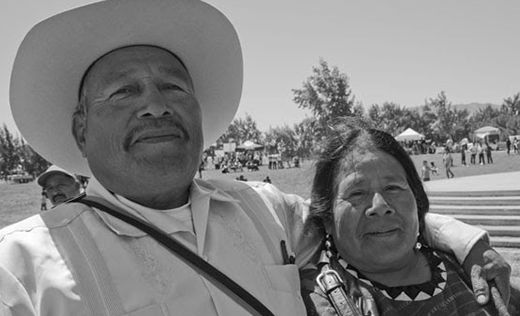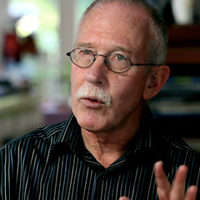
Pedro Alvarez was born in the Triqui-speaking town of Santa Cruz Rio Venado in Oaxaca, and came to the U.S. in 1985, after his father was murdered. He was one of the first Triquis to migrate to the U.S. Today he is a respected elder of a community that has grown to many thousands of people, spread through the farm worker towns of the Salinas Valley, Sonoma County and beyond.
“When I got my first job at Sonoma Vineyards, I didn’t know how to do the work,” he recalls. “But eventually I learned how to prune, plant, tie vines and remove leaves, and then worked in the grape harvest.” He is an old man now, and still a farm worker.
In 1986 Alvarez got his permanent residence visa, or “green card,” through the farm worker amnesty, part of the Immigration Reform and Control Act. Once he had legal status he brought his wife and children to California. Here they had other children, and the family grew.
“Working in the fields has supported all of us, and made it possible to bring everyone,” he says. His children, however, don’t do farm labor any more. “They went on to study, and now they do other jobs. None of them work in the fields. But that’s still the way my wife and I put food on the table.”
Triquis in California are among the state’s most recent migrants, and because they arrived after the amnesty, most are undocumented. Triquis are also among the poorest workers in agriculture. Perhaps because Alvarez came earlier and got legal status, his family gained a kind of economic stability that most Triquis don’t have. The Alvarez children may be leaving the fields, but they are still a big presence in the Triqui community. Last weekend one of Pedro Alvarez’ sons, Mariano, organized the country’s first Triqui cultural festival in Greenfield, where indigenous migrants make up more than half the town’s residents.
Pedro Alvarez believes agriculture is still the path to survival for his community, but like many others he gets angry about the low wages. “Working here doesn’t pay much, but if you haven’t studied, there’s no alternative,” he concludes. “There will always be work in the fields for those who need it, but maybe in the future it will pay better. The price of food is always going up, and people aren’t so willing to work in the places that pay the worst. There aren’t as many workers right now, so growers have to raise wages a little to get people.”
The militarized border with Mexico makes crossing more expensive and dangerous, and traps many families here. Yet people continue to cross, looking for work. Pedro’s nephew Federico recently returned from Oaxaca, where he’d gone to get married to Araceli Rosales [Their names have been changed to protect their identity]. As the couple ate tlayudas (tostadas on big Oaxacan tortillas) and watched the dances at the festival in Greenfield’s Pioneer Park, Federico was looking forward to the coming work season in the Salinas Valley. But he also worried that his new family might not be able to live on the pay.
“Economically, it’s hard to support us with this work,” he explained. “When I’m working I can do it, but when there’s no work it’s impossible. There are really only five months when I have work all the time. Other than that, I’m mostly working two or three days a week.”
To Federico, field work is still a good job, “but really, there’s no alternative,” he says. “I can’t get a job in construction or working in a warehouse because they ask you for papers there. If you don’t have papers they won’t hire you. I’ll be working in the fields for many years to come. It has its ups and downs, but it’s what my life depends on.”
Alejandro Alvarez, Pedro’s oldest son, is angrier. He came with his father years ago, and put himself through high school, and later college, working beside him in the grapes. Today he’s a skilled technician in a winery, but he doesn’t see field labor as unskilled work.
“Only the people working out there know how to do it,” he charges. “If it wasn’t for them the crops wouldn’t get grown or harvested. Sometimes I think about what would happen if nobody went to work in the fields for one or two days. It would be chaos.” Alejandro compares farm work to a job in the winery warehouse, “where they pay overtime and sick leave, where people get breaks and foremen can’t just punish someone. When I look at people working in the field, I see a lack of equality.”
Nevertheless, he doesn’t think Triquis accept these conditions passively. “Little by little people are waking up,” he asserts. “The people who have crops they need planted and harvested should listen and pay attention to what our lives are actually like. For the next generation, there will be a change.”
The festival shows Triquis are proud of their culture, he explains, and are trying to find a secure place in Greenfield. The town has at times welcomed migrants, while at other times its leaders have been hostile and even called immigration authorities.
Triquis will wind up following the path made by other migrant groups in California agriculture, Alejandro Alvarez predicts. “The Filipinos did it, and Triquis are now following them. We are very creative, and here we are communicating the best part of ourselves.”
Photo: Pedro Alvarez and his wife Ana Merino, leaders of the Triqui community in California. | David Bacon










